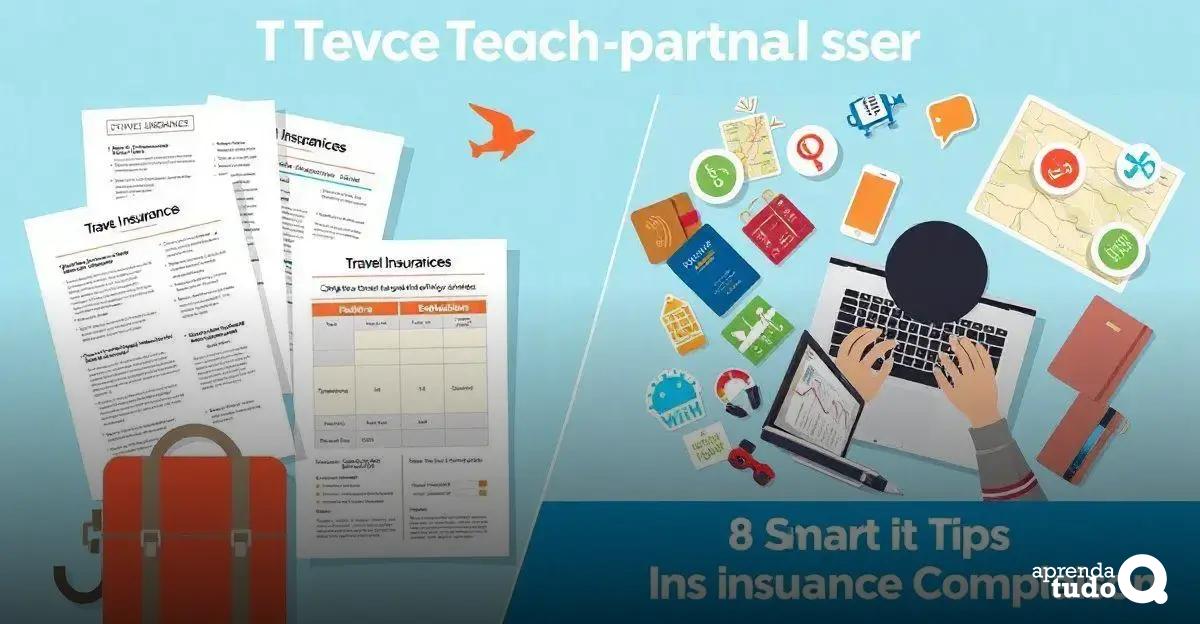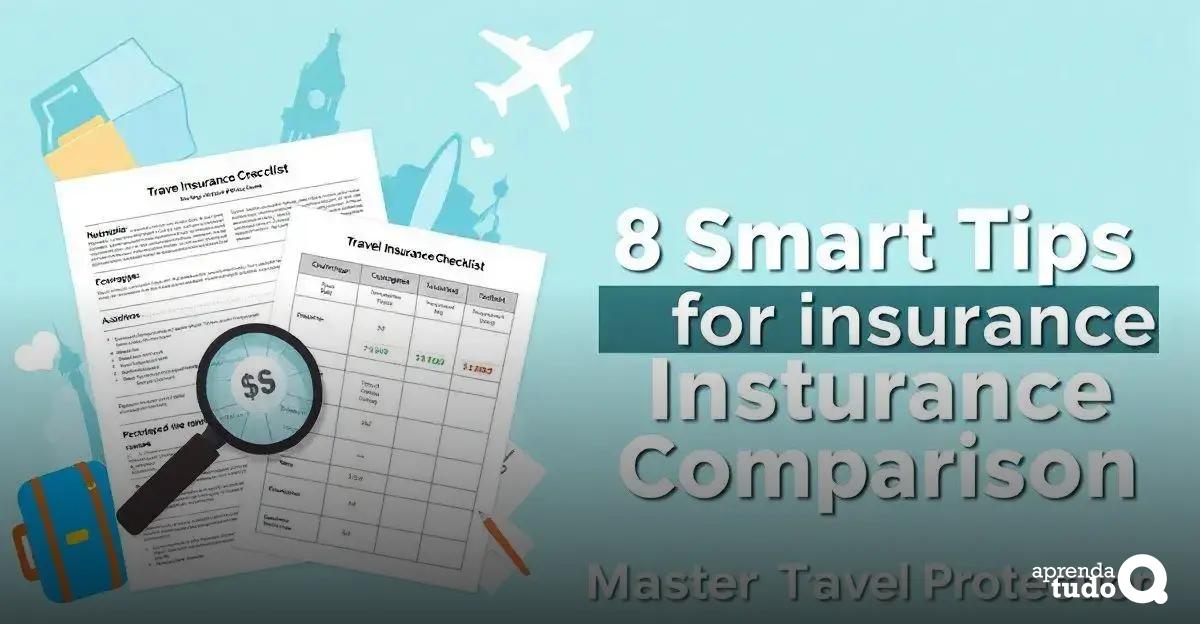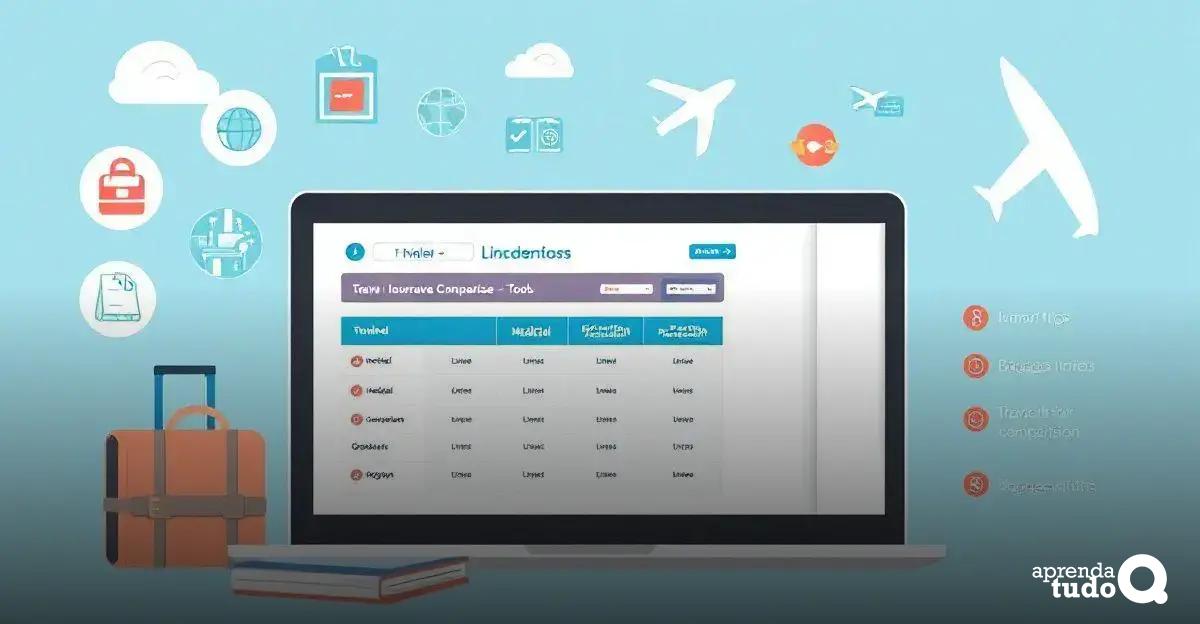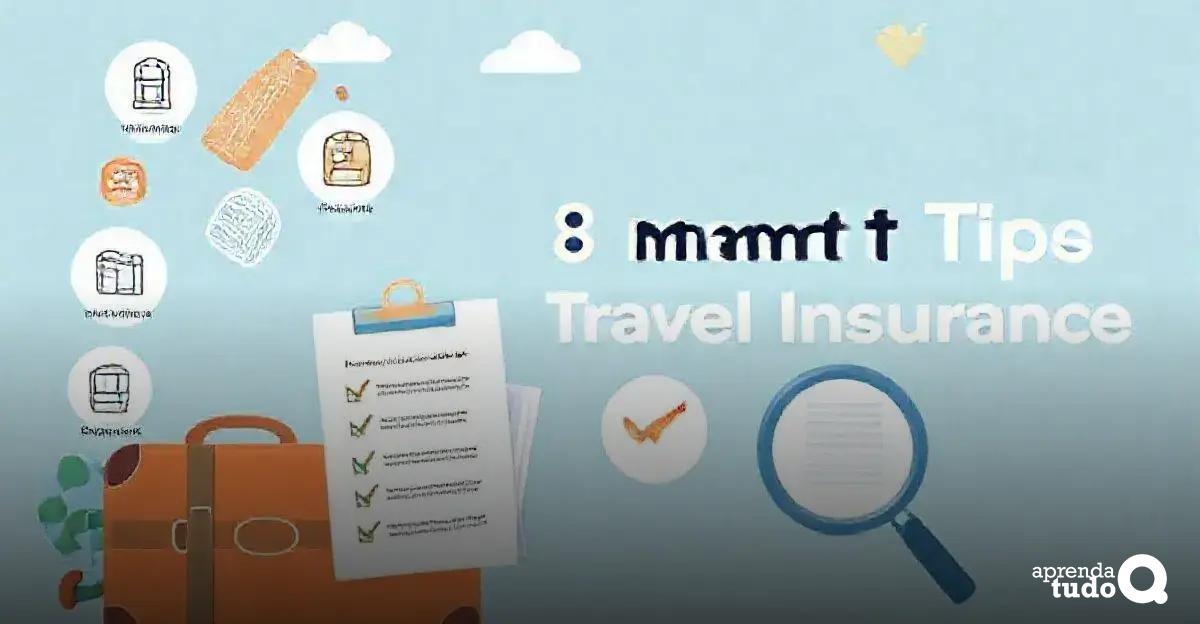When planning your next adventure, understanding travel insurance comparison is essential.
After all, travel insurance is your safety net against unexpected events, whether it’s a cancelled flight, lost luggage, or sudden illnesses abroad.
With so many options available, making the right choice can feel overwhelming.
This guide will walk you through the benefits of comparing different travel insurance policies, helping you find the best coverage for your peace of mind on your travels.
Understanding Travel Insurance
Understanding Travel Insurance is the first step in ensuring you are fully protected when travelling.
At its core, travel insurance is designed to cover financial losses that can arise from various travel-related incidents.
Typically, there are two main components to consider: medical cover and trip cancellation cover. Medical cover takes care of expenses related to illness or injury while travelling. This is particularly crucial if you’re venturing to destinations where healthcare might be costly or hard to access.
On the other hand, trip cancellation cover reimburses you for non-refundable expenses if you need to cancel your trip due to unforeseen circumstances such as illness, a personal emergency, or other legitimate reasons.
It’s essential to recognise that not all policies are created equal. Some may include additional benefits such as coverage for lost or stolen belongings, travel delays, or emergency evacuation. Thus, it becomes important to dissect what each policy offers and determine how it aligns with your specific travel needs.
Moreover, engaging in a travel insurance comparison helps to illuminate the differences in coverage, costs, and customer service ratings among providers. This ensures that you don’t only select the cheapest option but one that offers comprehensive support to keep you safe during your journey.
In summary, a solid grasp of travel insurance basics will empower you to make informed decisions, paving the way for more enjoyable travel experiences without the shadow of worrying about the unexpected.
The Importance of Comparing Policies

The Importance of Comparing Policies cannot be overstated, especially when it comes to travel insurance. With a myriad of options available, taking the time to compare various policies can save you not only money but also a lot of hassle when you need coverage the most.
Firstly, different insurance providers offer varied levels of coverage. By comparing policies, you can identify those that align best with your travel habits. For instance, if you often travel for adventure sports, you’ll want a policy that covers high-risk activities like skiing or scuba diving. Conversely, if you plan a peaceful holiday, it may not be necessary to pay for extensive coverage.
Additionally, comparing policies allows you to highlight crucial differences in exclusions and limitations. Some policies might seem appealing at first glance due to lower premiums, but upon closer inspection, you may discover significant limitations that could leave you vulnerable. For example, one policy may not cover delays due to natural disasters, while another might. Understanding these nuances can be pivotal in ensuring you’re adequately protected.
Moreover, customer service plays a vital role when selecting travel insurance. By comparing reviews from previous customers, you can gauge how easily you can reach the insurer and how effectively they handle claims. After all, the last thing you want when faced with a stressful situation abroad is to struggle with poor customer service.
Lastly, price comparison is essential. Premiums can vary dramatically between providers for similar coverage types. By taking the time to compare costs, you can often find better deals and ensure that you’re not overpaying for your travel insurance.
In essence, comparing travel insurance policies is crucial for making an informed decision that caters to your individual needs and offers the best protection for your upcoming journeys.
Types of Travel Insurance Available
Types of Travel Insurance Available vary widely, catering to diverse needs and preferences of travellers. Understanding these options is key to selecting the right policy for your unique situation.
Firstly, there’s comprehensive travel insurance, which typically offers broad coverage, including medical expenses, trip cancellations, lost luggage, and personal liability. This type is ideal for those seeking extensive protection for various potential risks during their travels.
Next, we have medical travel insurance, which focuses solely on medical-related expenses incurred during your trip. This policy is essential for those travelling internationally, especially to places where healthcare costs can be exorbitantly high. It covers emergency medical treatment, hospital stays, and sometimes includes evacuation back to your home country.
Another option is trip cancellation insurance, which provides reimbursement for pre-paid, non-refundable expenses if you need to cancel your trip due to unforeseen circumstances. This can protect you against financial losses caused by emergencies or unexpected events preventing you from travelling.
Then there’s travel accident insurance, which pays out in the event of severe injuries or death resulting from an accident while travelling. This type of policy may also cover accidental death benefit for your family if the worst should occur.
For those heading for adventure, adventure sports insurance could be a necessity. Unlike standard policies, this type of insurance covers activities like skiing, scuba diving, or mountaineering that are often excluded from regular travel insurance plans.
Lastly, annual multi-trip insurance is a great option for frequent travellers. Instead of purchasing insurance for each trip, this policy allows you to take multiple trips throughout the year with one policy covering all journeys, often at a reduced cost.
With such a variety of travel insurance types available, it’s crucial to carefully assess your needs and select a policy that offers the right balance of coverage, convenience, and cost-effectiveness.
Key Features to Look For

When evaluating travel insurance, identifying the key features to look for can make a significant difference in your overall experience and peace of mind while travelling.
Here are some crucial elements to consider:
1. Medical Coverage: One of the most vital aspects of any travel insurance policy is comprehensive medical coverage. Ensure the policy covers hospital stays, emergency treatment, and potential evacuation. Check the policy limits, and make sure they are sufficient for your travel destination, especially if you’re venturing to places with high medical costs.
2. Trip Cancellation and Interruption Cover: Policies with trip cancellation cover reimburse you for non-refundable expenses if your journey is interrupted due to unforeseen events. Look for provisions that cover a wide range of reasons – the broader the coverage, the better.
3. Coverage for Baggage Loss or Delay: Losing your luggage can be a nightmare when you’re travelling. Ensure your policy provides compensation for lost, stolen, or damaged baggage. Additionally, some policies offer coverage for delayed luggage, which can be a lifesaver if you need to purchase essentials while waiting for your belongings.
4. 24/7 Assistance: Access to a reliable emergency hotline can be invaluable. Ensure your insurance provider offers 24/7 assistance to help with emergencies, such as finding a local hospital or replacing a lost passport. This provides an extra layer of security, ensuring you’re supported even in the toughest situations.
5. Activity Coverage: If you plan to engage in specific activities, confirm your policy covers them. Many standard policies exclude high-risk activities like skiing or scuba diving, so look for those that offer adventure sports coverage if you’re seeking thrill on your travels.
6. Pre-existing Medical Conditions: If you have any pre-existing medical conditions, check how the policy addresses them. Some insurers automatically exclude these conditions, while others may offer tailored coverage. Understanding the nuances in these provisions can save you from unexpected costs in case of a medical emergency.
7. Claims Process: A straightforward claims process is a must. Review customer feedback on how easy it is to file a claim and the responsiveness of the insurance provider. You never want to be bogged down with bureaucracy when dealing with a claim, so a smooth process is essential.
By focusing on these key features, you can create a solid foundation for your travel insurance decision, ensuring your journey goes as smoothly as possible.
Common Exclusions in Travel Insurance
Understanding the common exclusions in travel insurance is just as important as knowing the covered features. Insurers typically set boundaries on what their policies will and won’t cover, which can lead to unfortunate surprises if you’re not informed.
Here are a few exclusions you should be aware of:
1. Pre-existing Medical Conditions: Many travel insurance policies exclude coverage for pre-existing medical conditions. If you have a health condition that can affect your travels, it’s essential to disclose this to your insurer and check if they offer any coverage options tailored for it.
2. High-Risk Activities: Engaging in activities deemed high-risk—such as extreme sports, skydiving, or scuba diving—often falls outside standard policy coverage. If your travels include adventurous pursuits, make sure your policy specifically covers these activities to avoid potential out-of-pocket expenses.
3. Travel to High-Risk Destinations: Policies may exclude coverage if you’re travelling to regions classified as high-risk due to factors like political instability, natural disasters, or security concerns. Always check travel advisories and ensure your insurance policy remains valid for your intended destination.
4. Alcohol and Drug-Related Incidents: Most insurers will not cover claims related to injuries or incidents that occur while you are under the influence of drugs or excessive alcohol. This means that if your drinking leads to an accident or injury, you may be left to shoulder the costs yourself.
5. Trip Cancellation due to Work: Insurance typically won’t cover cancellations made simply because your employer requires you to work unexpectedly unless specifically included in the policy. Always read through the cancellation terms carefully to avoid losing any prepaid travel expenses.
6. Acts of God: Various policies may exclude coverage for natural disasters or ‘Acts of God’, such as earthquakes or floods. While some policies might offer limited coverage, others may not cover any costs related to these events, so it’s vital to check the details.
Being aware of these common exclusions can help you make a more informed decision while selecting travel insurance. By understanding the limitations of your chosen policy, you can better prepare and mitigate any risks you face during your travels.
How to Use an Online Comparison Tool

Using an online comparison tool can significantly simplify the process of finding the right travel insurance policy. Here’s a step-by-step guide to help you navigate this handy resource:
1. Identify Your Needs: Before you dive into any comparison tool, take a moment to clarify what you need in a travel insurance policy. Are you looking for extensive medical coverage, trip cancellation insurance, or specific coverage for adventure sports? Having a clear idea of your requirements will help you filter the options effectively.
2. Gather Your Travel Details: Input your travel details into the comparison tool. This usually includes your destination, length of travel, and the number of travellers. This information is crucial as it helps the tool generate relevant quotes tailored to your specific circumstances.
3. Evaluate the Results: Once you submit your information, the comparison tool will display a list of available policies side by side. Take the time to review each option and compare key features, coverage limits, and premiums. Pay attention to exclusions and specific benefits that may be particularly relevant to your planned activities.
4. Read the Fine Print: As tempting as it may be to choose the cheapest option, always read the fine print before making a decision. Look for details about the claims process, customer support, and any hidden fees that could crop up later. Ensure that the policy aligns with your expectations.
5. Check for Discounts or Offers: Many comparison tools highlight insurers that may be running special promotions or discounts. Take note of any limited-time offers that could save you money on your policy. However, don’t let discounts alone dictate your choice; the coverage and peace of mind are paramount.
6. Finalise Your Choice: Once you’ve narrowed down your options based on your needs, take the time to thoroughly revisit the top contenders. Compare their customer reviews and claims satisfaction ratings. This step will help ensure that you choose an insurer with a solid reputation.
7. Purchase Your Policy: After making your final decision, the comparison tool usually directs you to the insurer’s website to complete your purchase. Ensure you have all the necessary information handy, and don’t hesitate to reach out to customer service if you have any questions.
Utilising an online comparison tool is an excellent way to streamline the often overwhelming process of selecting travel insurance. By following these steps, you’ll be better equipped to find a policy that not only meets your needs but also gives you confidence and security as you embark on your adventures.
Reading the Fine Print
Reading the Fine Print is a crucial step often overlooked when selecting travel insurance. It can be tempting to skim over the lengthy documents, but taking the time to understand the details can save you from potential headaches later. Here’s what to focus on:
1. Coverage Limits: Policies typically come with specific limits on how much they will pay for different types of claims. For example, medical expenses may have a cap, and understanding these limits is essential to ensure you’re adequately protected, especially if you’re traveling to destinations with high medical costs.
2. Exclusions and Limitations: As discussed earlier, insurers may include numerous exclusions and limitations in their policies. These often include pre-existing medical conditions, high-risk activities, or specific events like natural disasters. Familiarise yourself with these exclusions to know what risks you are voluntarily accepting.
3. Claims Process: Understanding how to file a claim is vital. The fine print should detail the necessary steps, documentation, and deadlines. Some insurers may have strict timeframes for reporting claims, and missing these deadlines could lead to denial of coverage.
4. Conditions for Coverage: Some policies may have specific conditions that must be met for coverage to apply. For example, you may need to seek medical treatment within a designated time frame after an incident occurs. Understanding these conditions will help ensure you’re not caught off guard should you need to make a claim.
5. Customer Support: Check the fine print for information about customer support availability. Knowing if the insurer offers 24/7 assistance and how to reach them is essential if you face an emergency while travelling.
6. Policy Changes: Sometimes, insurers reserve the right to modify policy terms. Pay attention to any clauses regarding changes in premiums or coverages as your travel dates approach. You want to ensure that your policy remains effective without surprises.
7. Cancellation Policy: Understand the conditions under which you can cancel your policy and if there are any fees associated with cancellation. Having this knowledge can provide peace of mind in case your travel plans change unexpectedly.
By taking the time to read and understand the fine print, you’ll empower yourself with the knowledge necessary to make informed decisions and avoid potential pitfalls. Remember, the devil is often in the details, and being proactive can lead to better protection and experience during your travels.
Tips for Finding the Best Deals

When searching for the best travel insurance, knowing some tips for finding the best deals can help you save money while ensuring you get adequate coverage. Here are some practical strategies to maximise your savings:
1. Start Early: Begin your search for travel insurance well in advance of your trip. Booking early often gives you access to lower premiums and better choices, as last-minute policies can be more expensive and less comprehensive.
2. Compare Multiple Providers: Don’t settle for the first quote you receive. Use online comparison tools to evaluate policies from various providers side by side. This allows you to quickly identify which insurers offer the best value for your specific needs.
3. Look for Discounts: Many insurance providers offer discounts for certain groups, such as students, seniors, or families. Additionally, if you’re a member of a travel association or club, inquire about exclusive offers that could lead to additional savings.
4. Consider Annual Multi-Trip Insurance: If you travel frequently throughout the year, consider purchasing annual multi-trip insurance instead of single-trip policies for each journey. This can be a more economical option, as it often provides coverage for unlimited trips within a year at a flat rate.
5. Evaluate Your Coverage Needs: Assess your actual risk factors based on your travel itinerary. If you’re going on a simple trip with minimal risks, you may not need extensive coverage that comes with a higher premium. Tailoring your policy to your specific needs can yield significant savings.
6. Check for Bundling Options: Some insurers may offer discounts if you bundle travel insurance with other types of insurance, such as health, auto, or home insurance. It’s worth asking your current insurance provider if this is an option available to you.
7. Read User Reviews: Before making a final decision, take a look at customer reviews regarding the providers you’re considering. Experiences reported by other travellers can give you insight into the quality of coverage, claims process, and assistance services.
By following these tips, you can arm yourself with the knowledge necessary to secure the best travel insurance deal. A little research goes a long way, ensuring that you’re well-protected on your adventures without breaking the bank.






